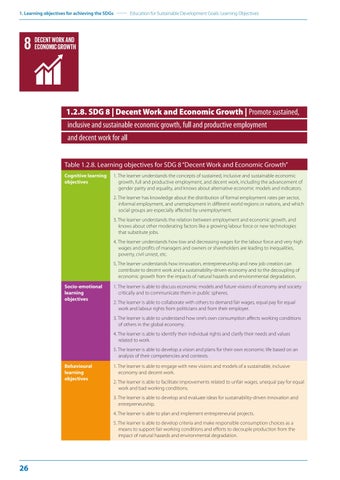1. Learning objectives for achieving the SDGs
Education for Sustainable Development Goals: Learning Objectives
1.2.8. SDG 8 | Decent Work and Economic Growth | Promote sustained, inclusive and sustainable economic growth, full and productive employment and decent work for all Table 1.2.8. Learning objectives for SDG 8 “Decent Work and Economic Growth” Cognitive learning objectives
1. The learner understands the concepts of sustained, inclusive and sustainable economic growth, full and productive employment, and decent work, including the advancement of gender parity and equality, and knows about alternative economic models and indicators. 2. The learner has knowledge about the distribution of formal employment rates per sector, informal employment, and unemployment in different world regions or nations, and which social groups are especially affected by unemployment. 3. The learner understands the relation between employment and economic growth, and knows about other moderating factors like a growing labour force or new technologies that substitute jobs. 4. The learner understands how low and decreasing wages for the labour force and very high wages and profits of managers and owners or shareholders are leading to inequalities, poverty, civil unrest, etc. 5. The learner understands how innovation, entrepreneurship and new job creation can contribute to decent work and a sustainability-driven economy and to the decoupling of economic growth from the impacts of natural hazards and environmental degradation.
Socio-emotional learning objectives
1. The learner is able to discuss economic models and future visions of economy and society critically and to communicate them in public spheres. 2. The learner is able to collaborate with others to demand fair wages, equal pay for equal work and labour rights from politicians and from their employer. 3. The learner is able to understand how one’s own consumption affects working conditions of others in the global economy. 4. The learner is able to identify their individual rights and clarify their needs and values related to work. 5. The learner is able to develop a vision and plans for their own economic life based on an analysis of their competencies and contexts.
Behavioural learning objectives
1. The learner is able to engage with new visions and models of a sustainable, inclusive economy and decent work. 2. The learner is able to facilitate improvements related to unfair wages, unequal pay for equal work and bad working conditions. 3. The learner is able to develop and evaluate ideas for sustainability-driven innovation and entrepreneurship. 4. The learner is able to plan and implement entrepreneurial projects. 5. The learner is able to develop criteria and make responsible consumption choices as a means to support fair working conditions and efforts to decouple production from the impact of natural hazards and environmental degradation.
26


